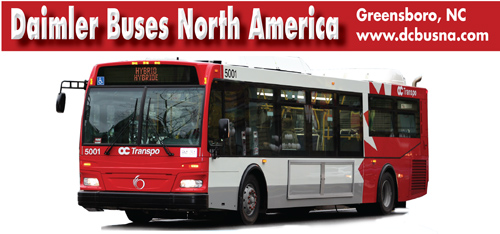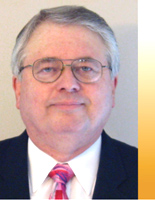 Foton America Bus Co., Inc. was founded to compete on the world stage with the best manufacturing companies. Where lead times in the North American market are typically between 12-18 months, Foton America currently builds 500 custom ordered buses a month overseas and is able to deliver on entire orders within six months. Foton American alternative fuel technology is available in hybrid diesel electric, CNG, LNG and hydrogen. The Foton L40 CNG bus offers comfort and drivability demanded in today’s transit market. The widened front entrance allows ample space for wheelchair access, while a large front windshield allows greater driver visibility and an open feel to the interior.
Foton America Bus Co., Inc. was founded to compete on the world stage with the best manufacturing companies. Where lead times in the North American market are typically between 12-18 months, Foton America currently builds 500 custom ordered buses a month overseas and is able to deliver on entire orders within six months. Foton American alternative fuel technology is available in hybrid diesel electric, CNG, LNG and hydrogen. The Foton L40 CNG bus offers comfort and drivability demanded in today’s transit market. The widened front entrance allows ample space for wheelchair access, while a large front windshield allows greater driver visibility and an open feel to the interior.
 Jared Schnader
Jared Schnader
vice president, marketing and development
“The current economic downturn has left people with less money to run their businesses, use their cars and purchase new equipment. With the Obama administration comes an increased interest in alternative fuels, perpetuated by volatile fluctuation within the diesel economy. The movement to take cars off the road is exciting for the transit bus industry, and Foton America is excited to be coming into a market ready and eager to make changes.
The goal of Foton America is to offer every product for less than current market prices. In times of difficulty, people just need a little help and Foton America is pushing to be of assistance.”
 Proterra develops and supplies economically and environmentally sustainable vehicle drive systems and complete vehicle solutions to urban heavy duty transportation.The Proterra 35-ft EcoRide is a purpose built fast-charge, battery electric composite body 65+ passenger transit bus. The system can re-charge on route using a roadside 10 minute fast charging system. The bus also is available with optional range extension diesel, gasoline, CNG or H2 fuel cell APUs.
Proterra develops and supplies economically and environmentally sustainable vehicle drive systems and complete vehicle solutions to urban heavy duty transportation.The Proterra 35-ft EcoRide is a purpose built fast-charge, battery electric composite body 65+ passenger transit bus. The system can re-charge on route using a roadside 10 minute fast charging system. The bus also is available with optional range extension diesel, gasoline, CNG or H2 fuel cell APUs.
 Jeff Granato
Jeff Granato
president and CEO
“The solution is in our hands to help cities reduce air and noise pollution, and the state and federal policies are also in place to begin to take clean commuting from a vision to a reality in 2009. Proterra believes the introduction of the EcoRide BE35 to California is an immediate next step all transit agencies can take to achieve emissions-free transit.”
 Daimler Buses North America (DBNA) has drawn upon its extensive worldwide network to meet the upcoming EPA 2010 emission standards, calling on its colleagues in other markets around the world to help eliminate mistakes by using proven components and systems, which translate into improved reliability and durability.
Daimler Buses North America (DBNA) has drawn upon its extensive worldwide network to meet the upcoming EPA 2010 emission standards, calling on its colleagues in other markets around the world to help eliminate mistakes by using proven components and systems, which translate into improved reliability and durability.
DBNA 2010 After Treatment System (ATS) installation for the Cummins ISB hybrid and ISL diesel engines includes the new Selective Catalytic Reduction (SCR) system and current Diesel Particulate Filter (DPF), as well as the Diesel Emission Fluid (DEF) tank and supply system from the Citaro city bus platform, which has been in service in Europe for the past three years.
 Pat Scully
Pat Scully
chief operating officer
“In 2010, the heavy-duty bus and truck market faces another emissions change as required by the EPA. This may be the first time such a change does not have an adverse effect on fuel economy. With the advent of Selective Catalytic Reduction (SCR), we will probably see a slight improvement in mpg over EPA 2007 engines — great news for the industry especially in times of dynamic fuel costs.
Along with this improvement for 2010, Orion transit buses will deliver a fully tested and designed storage and metering system. DBNA ensures its customers that systems and components are fully tested and validated before coming to market.”
Xcelsior encapsulates its spirit of continuous improvement at New Flyer. This new 40-ft diesel-electric hybrid vehicle is the next step in the customer-centric evolution of transit buses, building on only the most significant improvements to existing New Flyer models. Xcelsior weighs in 10 percent lighter to deliver improved fuel economy.
The advanced vehicle design and upgraded styling incorporates a redesigned bumper and LED headlamps. The rooftop A/C and improved insulation reduce noise, and larger windows with narrower pier panels improve the view.
 Paul Saubry
Paul Saubry
president and CEO
“All customer feedback is important and I truly believe that by listening and working together we can create solutions that will address the rapidly changing needs of our customers. There is so much positive momentum in the industry, I am confident we can create world-class transit solutions in this period of unprecedented growth. I look forward to working closely with our people, the transit agencies and our suppliers to continue to produce vehicles with product and performance innovations.”
Available in 45-ft or 40-ft lengths, the MCI D-Series is Buy America compliant and has completed Altoona testing for both its clean-diesel and diesel-electric hybrid model lineup. Enhanced safety and performance features include electronic stability control and the optional SmartWave tire-pressure monitoring system. Operators can invest in the optional Amerex fire suppression system, reverse sensing, GPS and video surveillance systems.
Among the options gaining in popularity on the D-Series are digital wireless WiFi and 110-volt outlets that allow riders to use their laptops or WiFi enabled devices. The sleek and curvy D-Series models offer solid stainless steel construction and easy maintenance that has made them the all-time best-selling coaches in the motorcoach industry.
 Michael Melaniphy
Michael Melaniphy
vice president, public sector
“The future will have its challenges but the good news is ridership in scheduled service and public transportation continues to increase. New commuter routes provide access to jobs, take cars off of crowded highways and can be placed into service quickly. High-capacity over-the-road coaches with seating for up to 57 passengers are an excellent application for these funds.
Additionally, the new administration has earmarked funds in its stimulus package to help public transportation grow and flourish for years to come. Stimulus funds are subject to all existing federal procurement regulations regardless of whether an operator serves the private or public sectors. MCI can help and is encouraging operators to learn more by visiting the FTA Web site for information on the American Recover and Revitalization Act – ARRA (stimulus money) for buses.”
The true low-floor 60-ft articulated Van Hool AG300 is ideal for Bus Rapid Transit (BRT) operations and other high volume passenger applications. As a true low floor front to rear, the design allows for up to four passenger doors to maximize passenger ingress and egress to minimize dwell times and speed the operation. The puller design provides enhanced control during low traction conditions and also allows a rear window for enhanced visibility.
Top cooling is a unique feature of the Van Hool AG300. The radiator, charge air cooler and oil cooler is roof-mounted at the front of the vehicle. The front roof cap cowling design creates a scoop effect to draw air over the coils to supplement the cross flow blower. This superior location brings the radiator up and away from the rear of the bus where road debris such as mud, leaves and trash can easily clog and reduce radiator performance. Other benefits include a smaller engine compartment with lower compartment temperatures.
 John Andrews
John Andrews
vice president, public sector
“If there was ever a definition of the perfect storm in the transit industry, it is record ridership while struggling to meet the budgetary challenges of declining revenues.
As the nation looks to reducing its dependence on foreign oil, reduce its carbon footprint and develop alternate forms of energy, the transit bus has a bright future helping to achieve those goals.
Current diesel and gas hybrids as well as CNG powered buses are providing a bridge to even less polluting vehicles in the years to come. We at ABC Companies are proud to represent Van Hool and their achievements with hydrogen fuel cell buses leading the way with partner UTC Power towards the ultimate zero emission technology.
While the price of a fuel cell bus is high, the price is roughly half of what it was 10 years ago. Improvements in fuel cell size, weight and battery performance will continue to bring this technology to the mainstream marketplace.”


